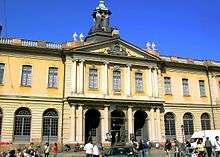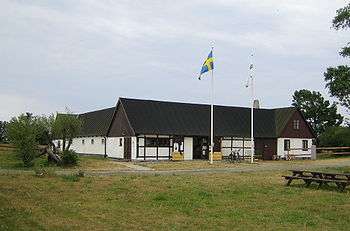Swedish Academy
 | |
| Motto |
Snille och Smak (Talent and taste) |
|---|---|
| Formation | 20 March 1786 |
| Headquarters | Stockholm, Sweden |
Membership | 18 members |
Permanent Secretary | Sara Danius |
| Website | http://www.svenskaakademien.se |
The Swedish Academy (Swedish: Svenska Akademien), founded in 1786 by King Gustav III, is one of the Royal Academies of Sweden. It is known for making the annual decision on who will be the laureate for the Nobel Prize in Literature, awarded in memory of the donor Alfred Nobel.
History

The Swedish Academy was founded in 1786 by King Gustav III. Modelled after the Académie française, it has 18 members. The motto of the Academy is "Talent and Taste" ("Snille och Smak" in Swedish). The primary purpose of the Academy is to further the "purity, strength, and sublimity of the Swedish language" ("Svenska Språkets renhet, styrka och höghet") (Walshe, 1965). To that end the Academy publishes two dictionaries.[1]
The first is a one-volume glossary called Svenska Akademiens ordlista (SAOL). The second is a multi-volume dictionary, edited on principles similar to those of the Oxford English Dictionary, entitled Svenska Akademiens Ordbok (SAOB). The SAOL has reached its 14th edition while the first volume of the SAOB was published in 1898 and, as of 2014, work has progressed to words beginning with the letter "V".
The building now known as the Stockholm Stock Exchange Building was built for the bourgeoisie. The bottom floor was used as a trading exchange (this later became the stock exchange) and the upper floor was used for balls, New Year's Eve parties, etc. When the academy was founded, the ballroom was the biggest room in Stockholm that could be heated and thus used in the winter, so the king asked if he could borrow it.

The academy has had its annual meeting there every year since, attended by members of the Swedish royal family.[2] However, it was not until 1914 the academy gained the right to use the upper floor as their own for all eternity. It is here that the Academy meets and, amongst other business, announces the names of Nobel Prize laureates. The latter makes it arguably one of the most influential literary bodies in the world.
Dag Hammarskjöld's former farm at Backåkra, close to Ystad in southern Sweden, was bought in 1957 as a summer residence by Hammarskjöld, then Secretary-General of the United Nations (1953–1961). The south wing of the farm is reserved as a summer retreat for the 18 members of the Swedish Academy, of which Hammarskjöld was a member.
It is not possible for members of the Academy to resign; membership is for life, although the Academy can decide to exclude members – this happened twice to Gustaf Mauritz Armfelt who was excluded in 1794, re-elected in 1805, and excluded again in 1811. In 1989, Kerstin Ekman and Lars Gyllensten chose to stop participating in the meetings of the Academy, over its refusal to express support for Salman Rushdie when Ayatollah Khomeini condemned him to death for The Satanic Verses, and in 2005, Knut Ahnlund made the same decision, as a protest against the choice of Elfride Jelinek as the Nobel laureate for 2004.[3][4]
Awards and prizes
Since 1901, the Academy has annually decided who will be the laureate for the Nobel Prize in Literature, awarded in memory of the donor Alfred Nobel.
The Swedish Academy annually awards nearly 50 different prizes and scholarships, most of them for domestic Swedish authors. Common to all is that they are awarded without competition and without application. The Dobloug Prize, the largest of these at $40,000, is a literature prize awarded for Swedish and Norwegian fiction.[5][6]
The Big Prize
Swedish: Stora Priset, literally the Big Prize, was instituted by King Gustav III. The prize, which consists of a single gold medal, is the most prestigious award that can be awarded by the Swedish Academy. It has been awarded to, among others, Selma Lagerlöf (1904 and 1909), Herbert Tingsten (1966), Astrid Lindgren (1971), Evert Taube (1972) and Tove Jansson (1994).
Other awards
The Academy awards around 50 prizes each year. A person does not have to apply nor compete for the prizes.
Full list of awards (in Swedish)
Current members
The current permanent secretary of the Academy is Sara Danius, who was preceded by Peter Englund. The current members of the Swedish Academy listed by seat number:
| Seat | Member | Born | Age | Elected | Notes |
|---|---|---|---|---|---|
| 1. | Lotta Lotass | 1964 | 52 | 2009 | |
| 2. | Bo Ralph | 1945 | 71 | 1999 | |
| 3. | Sture Allén | 1928 | 88 | 1980 | Permanent secretary 1986–1999 |
| 4. | Anders Olsson | 1949 | 67 | 2008 | |
| 5. | Göran Malmqvist | 1924 | 92 | 1985 | |
| 6. | Tomas Riad | 1959 | 57 | 2011 | |
| 7. | Sara Danius | 1962 | 54 | 2013 | Permanent secretary 2015- |
| 8. | Jesper Svenbro | 1944 | 72 | 2006 | |
| 9. | Torgny Lindgren | 1938 | 78 | 1991 | |
| 10. | Peter Englund | 1957 | 59 | 2002 | Permanent secretary 2009–2015 |
| 11. | Klas Östergren | 1955 | 61 | 2014 | |
| 12. | Per Wästberg | 1933 | 83 | 1997 | |
| 13. | Sara Stridsberg | 1972 | 44 | 2016 | |
| 14. | Kristina Lugn | 1948 | 68 | 2006 | |
| 15. | Kerstin Ekman | 1933 | 83 | 1978 | Inactive |
| 16. | Kjell Espmark | 1930 | 86 | 1981 | |
| 17. | Horace Engdahl | 1948 | 68 | 1997 | Permanent secretary 1999–2009 |
| 18. | Katarina Frostenson | 1953 | 63 | 1992 |
Permanent secretaries
| Order | Seat | Permanent Secretary of the Academy | Born | Years | Notes |
|---|---|---|---|---|---|
| 1. | 11. | Nils von Rosenstein | 1752 | 1786–1824 | |
| 2. | 13. | Frans Michael Franzén | 1772 | 1824–1834 | |
| 3. | 12. | Bernhard von Beskow | 1796 | 1834–1868 | |
| 4. | 5. | Johan Erik Rydqvist | 1800 | 1868–1869 | pro temporare |
| 5. | 15. | Ludvig Manderström | 1806 | 1869–1872 | |
| 6. | 12. | Carl Gustaf Strandberg | 1825 | 1872–1874 | pro temporare |
| 7. | 9. | Henning Hamilton | 1814 | 1874–1881 | |
| 8. | 11. | Bror Emil Hildebrand | 1806 | 1881–1883 | pro temporare |
| 9. | 8. | Carl David af Wirsén | 1842 | 1883–1912 | pro temporare in 1883–84 |
| 10. | 6. | Hans Hildebrand | 1842 | 1912 | pro temporare |
| 11. | 11. | Erik Axel Karlfeldt | 1864 | 1913–1931 | |
| 12. | 14. | Per Hallström | 1866 | 1931–1941 | |
| 13. | 13. | Anders Österling | 1884 | 1941–1964 | |
| 14. | 7. | Karl Ragnar Gierow | 1904 | 1964–1977 | |
| 15. | 14. | Lars Gyllensten | 1921 | 1977–1986 | |
| 16. | 3. | Sture Allén | 1928 | 1986–1999 | |
| 17. | 17. | Horace Engdahl | 1948 | 1999–2009 | |
| 18. | 10. | Peter Englund | 1957 | 2009–2015 | |
| 19. | 7. | Sara Danius | 1962 | 2015– |
See also
References
- ↑ Store norske leksikon (2005–2007). "Svenska Akademien". Store norske leksikon.
- ↑ http://www.kungahuset.se/royalcourt/royalfamily/latestnews/2011/2011/royalattendanceattheformalgatheringoftheswedishacademy.5.70e7de59130bc8da54e800014792.html
- ↑ "Nobel Judge Steps Down in Protest". BBC News Online. BBC. 2005-10-11. Retrieved 2007-10-13.
- ↑ Associated Press, "Who Deserves Nobel Prize? Judges Don't Agree", MSNBC, 11 October 2005. Retrieved 13 October 2007.
- ↑ Website of the Swedish Academy describing the prize (Swedish language))
- ↑ Store norske leksikon (2005–2007). "Doblougprisen". Store norske leksikon.
Other sources
- Walshe, Maurice O'Connell (1965). "Introduction to the Scandinavian Languages", Andre Deutsch Ltd., 1st edition, p. 57
External links
- Official website (Swedish)
- Official website (English)
- SAOL on the web – Free
- SAOB on the web – Free
Coordinates: 59°19′31″N 18°4′14″E / 59.32528°N 18.07056°E